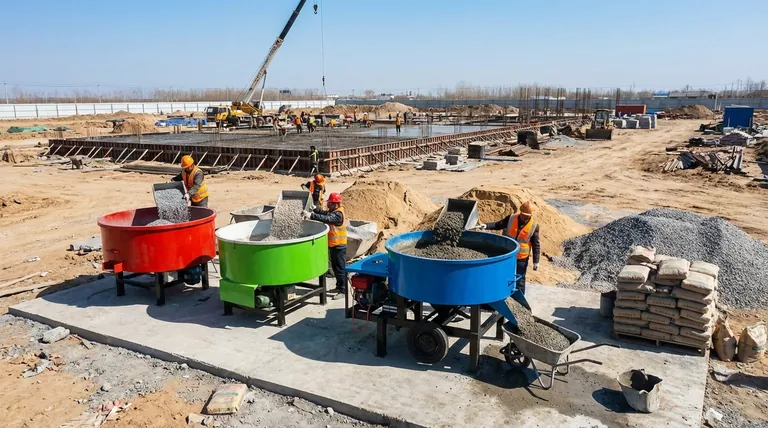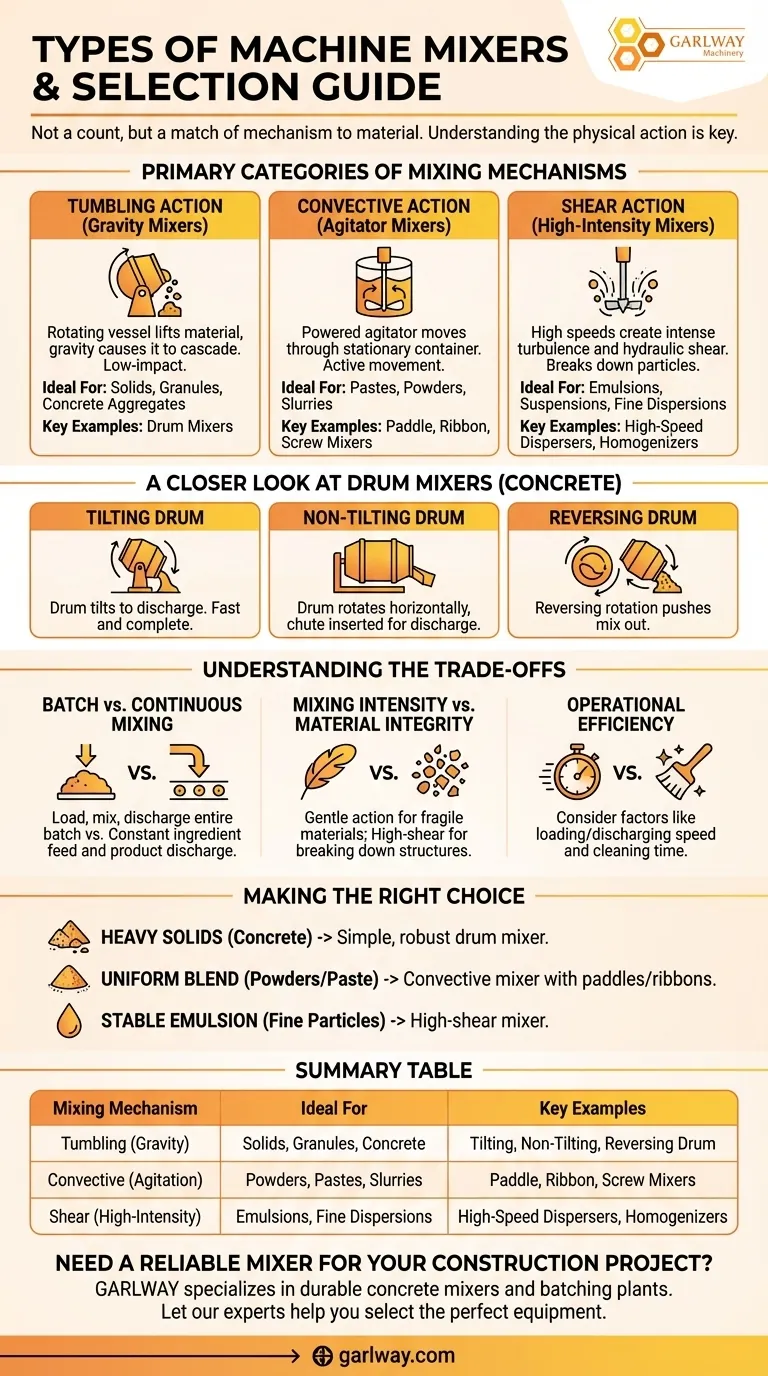While there is no single number, machine mixers are not defined by a simple count but are classified by their mixing mechanism and the materials they are designed to handle. For example, in the specific category of drum-type mixers used for concrete, there are three primary designs: tilting, non-tilting, and reversing, which are distinguished by how they discharge the material.
The most critical insight is not knowing how many types of mixers exist, but understanding that the right choice depends entirely on matching the mixer's physical action—such as tumbling, shearing, or agitating—to the properties of your specific material.

The Primary Categories of Mixing Mechanisms
To understand mixers, it's best to group them by how they work. The physical force applied to the material is the most important distinction.
Tumbling Action (Gravity Mixers)
These mixers use a rotating vessel, or drum, to lift the material. Gravity then causes the material to cascade and tumble over itself.
This method is relatively low-impact and is ideal for mixing solids, granules, and dense materials like concrete aggregates.
Convective Action (Agitator Mixers)
This is the largest category, where a powered agitator—such as a paddle, ribbon, or screw—moves through a stationary container.
These mixers actively force materials to move from one location to another, providing a more predictable and often faster mix for pastes, powders, and slurries.
Shear Action (High-Intensity Mixers)
Shear mixers operate at high speeds, creating intense turbulence and hydraulic shear. This force is necessary to break down particles and blend immiscible liquids.
They are essential for creating emulsions, suspensions, and fine dispersions, where simple agitation is not enough.
A Closer Look at Drum Mixers for Concrete
The drum mixer is a classic example of a tumbling mixer, widely used for its simplicity and effectiveness in handling heavy aggregates. The three types mentioned in your query differ primarily in their discharge method.
Tilting Drum Mixers
As the name implies, the entire drum pivots, or tilts, downwards to pour out the mixed concrete. This allows for a very fast and complete discharge.
Non-Tilting Drum Mixers
This design, as described in the reference, features a cylindrical drum that rotates on a horizontal axis with openings at both ends. It is loaded at one end and discharged by inserting a chute into the drum to catch the mix.
Reversing Drum Mixers
These mixers operate similarly to non-tilting types but discharge the material by simply reversing the direction of the drum's rotation. The design of the internal blades pushes the mix out of the drum when reversed.
Understanding the Trade-offs
Selecting a mixer involves balancing efficiency, cost, and the quality of the final product. There is no single "best" type.
Batch vs. Continuous Mixing
Drum and many agitator mixers are batch mixers—you load ingredients, mix them, and discharge the entire batch at once.
Other systems, especially for large-scale industrial processes, are continuous mixers, where ingredients are fed in and the product is discharged constantly.
Mixing Intensity vs. Material Integrity
A gentle tumbling action is perfect for fragile materials that could be damaged by aggressive mixing.
Conversely, a high-shear mixer that is essential for making mayonnaise would destroy the structure of a delicate powder blend.
Operational Efficiency
Factors like loading, discharging, and cleaning time are critical. A tilting drum mixer is very fast to empty, but a mixer with a removable trough might be far easier to clean thoroughly between different batches.
Making the Right Choice for Your Goal
Your final decision must be guided by the material you are working with and the outcome you need to achieve.
- If your primary focus is blending heavy solids like gravel and sand for concrete: A simple, robust drum mixer (tilting, non-tilting, or reversing) is the industry standard.
- If your primary focus is creating a uniform blend of powders or a thick paste: A convective mixer with paddles or ribbons will provide more consistent and efficient results.
- If your primary focus is creating a stable emulsion or dispersing fine particles into a liquid: A high-shear mixer is the only tool that can provide the necessary energy.
Ultimately, understanding the mechanism is the key to selecting the right machine for the job.
Summary Table:
| Mixing Mechanism | Ideal For | Key Examples |
|---|---|---|
| Tumbling (Gravity) | Solids, Granules, Concrete Aggregates | Tilting, Non-Tilting, Reversing Drum Mixers |
| Convective (Agitation) | Powders, Pastes, Slurries | Paddle, Ribbon, Screw Mixers |
| Shear (High-Intensity) | Emulsions, Fine Dispersions | High-Speed Dispersers, Homogenizers |
Need a Reliable Mixer for Your Construction Project?
Choosing the right mixer is critical for efficiency and quality. GARLWAY specializes in construction machinery, offering durable and efficient winches, concrete mixers, and concrete batching plants designed for the demands of construction companies and contractors globally.
Let our experts help you select the perfect equipment to match your specific materials and project goals.
Contact GARLWAY today for a personalized consultation and quote!
Visual Guide

Related Products
- Ready Mixer Machine for Construction Ready Mix Machinery
- Portable Concrete Mixer Machine Equipment for Mixing Concrete
- Commercial Construction Mixer Machine for Soil Cement Mixing Concrete
- Portable Ready Mix Concrete Mixer Equipment
- Hydraulic Concrete Mixer Machine Cement Mixing Equipment for Mixture Concrete
People Also Ask
- What safety considerations are important for concrete mixer operation? A Guide to Proactive Risk Management
- What was significant about Roscoe Lee's 1934 concrete mixer design? Pioneering Modular Construction Equipment
- Can a concrete mixer be used for mortar? Understanding the trade-offs for your project
- What should be considered regarding the output of a concrete mixer? Match Capacity to Your Project Scale
- Why is cleaning a concrete mixer after use important? Avoid Costly Repairs and Ensure Quality



















